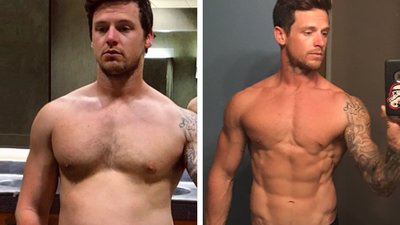Austin Naylor lived and breathed motocross. He was a serious competitor, and though he had suffered countless injuries, they had all healed well enough. Then everything changed on August 10, 2013, when his bike mis-shifted, he hit a triple jump in the incorrect gear, and he came up short.
"I went to the track just like any other day," he says. "I was doing my routine, not really focusing because I'd been riding so much and knew the course and jumps. Then I came around a hill and faced the biggest jump on the track. I was in the wrong gear, and my mind didn't even catch up until it was too late and I was in the air. I landed on my feet and knew instantly that they were broken."
From that point on, Austin's life changed forever. To move forward, he had to take a serious look at his health and his physical training, which had been totally focused on his sport. This is Austin's story.
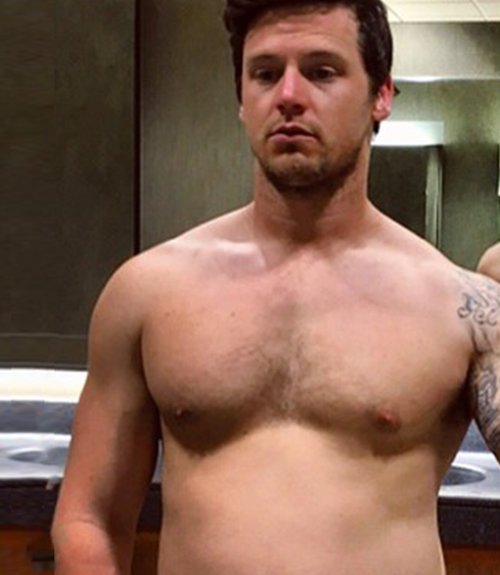
Age: 23, Height: 5'8", Weight: 170 lbs., Body Fat: 20%
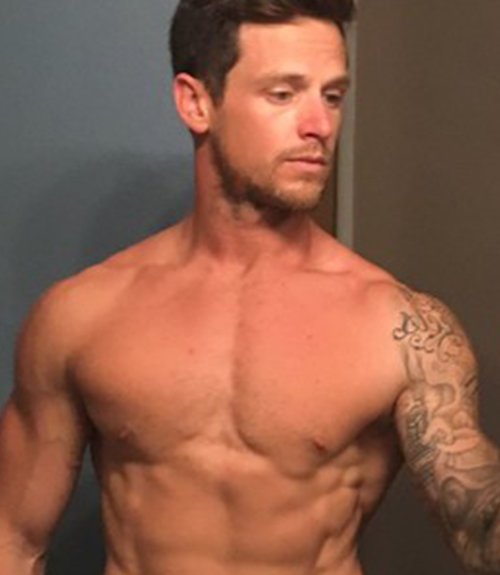
Age: 26, Height: 5'8", Weight: 150 lbs., Body Fat: 8%
Were you always into bikes?
I grew up in a motocross family. It's funny, because we lived two seconds from the beach but were always driving to the desert. My dad owned his own dirt bike when he was younger and put me on my first bike when I was about 5. It's in my blood, for sure. When I was younger, I'd get pulled out of school on Fridays to go out to the desert and camp out with friends and family. It was one of the best memories of my life.
It's a little scary at first, but once you learn to embrace the adrenaline rush, you want to get better at it. I guess it's like what Arnold says about the pump—there's nothing else like the crazy euphoria it brings. You just want to do it again and again. It's definitely addicting.
Lightness means speed in a sport like this, I imagine. Did you need seriously cardiovascular fitness to compete at motocross?
Yes, but you also have to be strong to ride dirt bikes. Ultimately, it's a cardio sport, because you're trying to go for 20-30 minutes gripping and holding on as hard as you can. A lot of people think it's really easy—you twist the throttle and the bike just goes—but you have to realize that you're holding on to this 250-pound machine that's trying to rip out from underneath you. It takes every muscle in your body to control it.
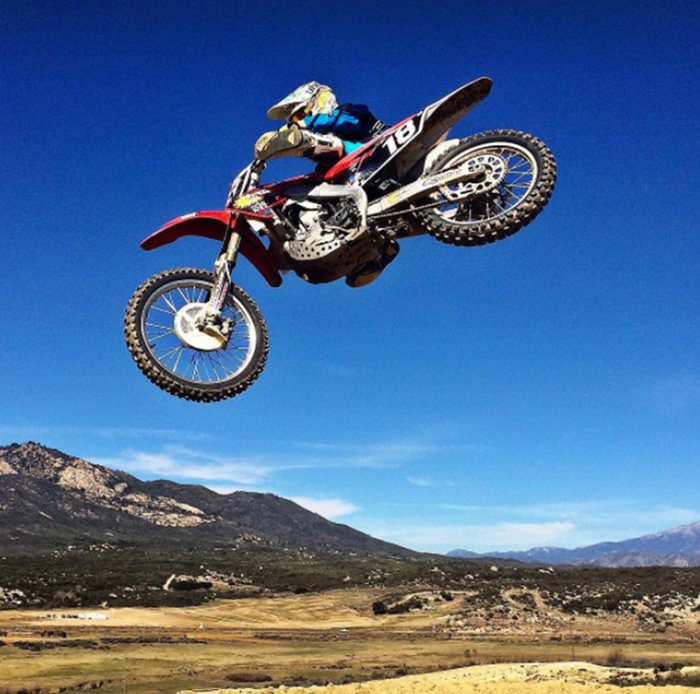
Still, I was mostly focused on cardio when I was younger. I never really lifted weights. I would always go run, but after my run I'd go pick up a cigarette and some beer, watch TV, and call it a day.
So even though you were a serious athlete, you weren't the epitome of fit.
Yeah. I got into drinking in high school, and after I went to mechanic school I started smoking cigarettes—something I was totally against initially. When you're around a bunch of guys, you take a puff here and there, and before you know it, it's a habit. I was easily a pack-a-day smoker and would buy four or five packs on weekends.
It was out of control, but I never really thought I was out of control. I still held a job, went to school, and paid my bills, but I wasn't living a healthy lifestyle—even though I thought I was perfectly fit and in shape.
What was your life like at the time of the accident?
Right before the accident, I was living life as good as I ever had. I'd started lifting weights, so I was at my peak physical conditioning, and I was riding the most I'd ever ridden. My racing was getting better and better, and I was going to try to and make it in the pro-amateur ranks. I'd had multiple injuries before—I've broken my collarbone, shoulder blade, multiple ribs, fingers, toes, and suffered a bruised lung—but my accidents all healed fine until August 10, 2013. That's when my life came crashing down.
I was doing my routine on the track, just like any other day. When I came around a hill, I just happened to face the biggest jump on the track. I was in the wrong gear and went flying about 80 feet and probably about 15 feet high. I landed on my feet and knew they were both broken. I crawled off the track, and had my brother and buddy pick me up and put me into their truck. I didn't want them to spend money on an ambulance. We drove about 25 minutes, and I instantly went in for surgery.
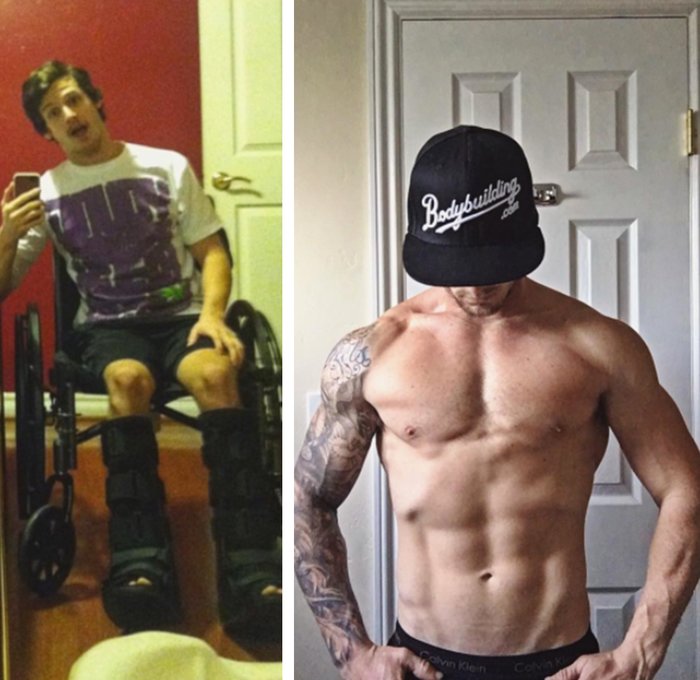
I was on the verge of losing my right foot, but luckily I had a family friend who got me treatments in a hyperbaric chamber—two hours a day every day for a month and a half in a big, clear tube. It stimulates your blood to pump extra oxygen into the tube so you get more white blood cells to stimulate blood flow, and it saved my foot.
However, as my right foot became better, my left foot, which never fully healed around the staples, got a bacterial infection. I had to have a picc line installed—that's basically an artificial vein that goes to your heart to pump antibiotics straight into your blood. I had a home nurse come every other day for a few months as well.
How were you handling all of these struggles personally?
I was pretty miserable in the hospital, and I definitely went from my highest point to my lowest. For the first few months, there was no good news—it was months of hearing "Sorry, this isn't healing" and "We're sorry, this is infected." Hearing that all the time destroyed me! For five months, I sat in bed with my feet up and kind of withered away. I lost hope.
Recovery was a lot of work—more than just slapping a cast on it, which is what I was used to before. I still can't do a lot of what I used to. I loved skateboarding—that was one of my biggest passions, too—but I can't do that anymore. I can't wakeboard or rock climb. I don't have very much ankle mobility in my right ankle and feel pain almost 24/7, but my left is better and can handle a little more.
The one good thing is that I can still throw on boots and go motocross. In my eyes, that's really all that matters. I try to stay positive and happy. I have both feet. I can walk and still do my favorite pastime. I couldn't have asked for more than that.
Was recovery smooth sailing from there?
The accident was in August, and I first stood on my feet in December. I got crutches at the beginning of January. The timing was bad, though, and because of an insurance deductible payment, I stopped going to physical therapy two weeks in.
But at first, the pain was also just too much. I developed bad eating habits, and I went right back to smoking cigarettes and drinking beer. At my heaviest, I'd always been around 135, but after sitting at home after the accident, I weighed 173 pounds. That may not be a lot for some people, but it was for me!
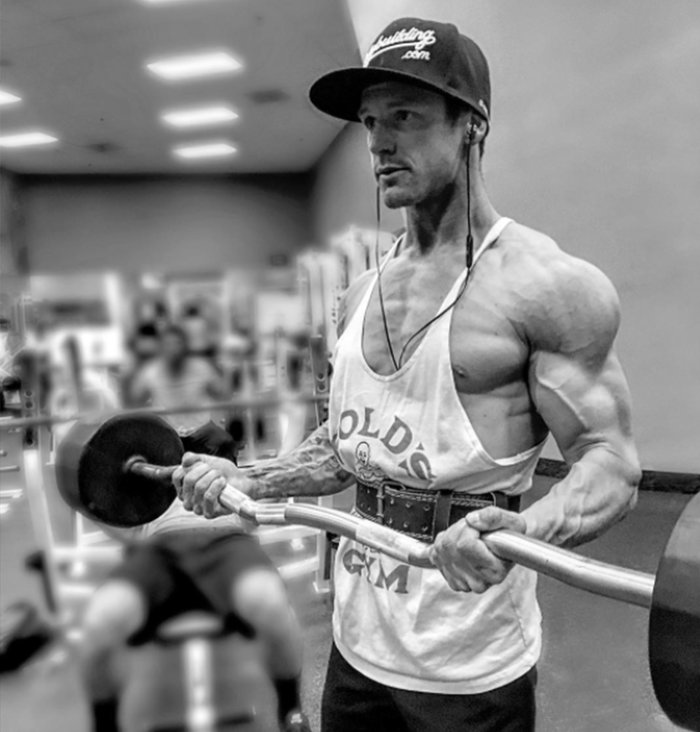
What was your wake-up call?
I saw a picture of me with my belly hanging over my pants button. I thought, "That's not me." I knew something had to change. That lit a fire inside me that said, "You're going to do what you want to do, and nothing is going to stop you."
You see people who are paralyzed doing crazy things. I've seen guys in wheelchairs doing backflips. For me to have both my feet and be able to walk and spend time crying like a little baby because I can't do what I want—what a joke. I needed to change my mindset and focus on making a better life with what I had, which was more than enough.
What supplements helped you along the way?
How did you get back into training?
It was hard to even want to think about training—let alone training legs! I would go into the gym and just get pissed because I couldn't press or squat. I was worried people were going to make fun of me for using such light weight, but I stopped caring.
I've always been a happy guy, but once I got into fitness, I found myself in an even more positive community. I've still had people come up to me and say, "Yo, bro, you need to hit legs." I just laugh and say that I know, because there are no excuses.
Honestly, if I didn't get into lifting, I don't think my feet would be nearly as good as they are today. Going to the gym automatically forced me to carry heavy dumbbells around, which helped my feet and legs get stronger.
My left foot is about 70 percent of what it used to be and my right is at about 40 percent, but I'm always moving forward.
What advice do you have for others struggling to find hope?
I'm not going to say that the gym is going to fix everything in your life, but I've never seen someone go in the gym and leave unhappy. I've never seen someone improve their health and fitness and not feel better.
Whether your problems are fitness- and weight-related or not, it doesn't matter. Just getting out and focusing on a healthier lifestyle affects everything in your life positively.


